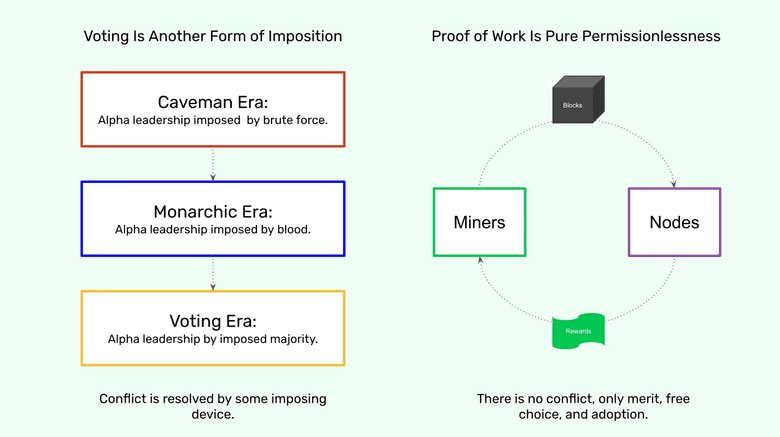Proof of Work Is Not Voting
You can listen to or watch this in video here:
In the blockchain industry, and in Ethereum Classic in particular, many think that the proof of work consensus mechanism is a voting system. This stems from a mistake Satoshi Nakamoto made when writing the Bitcoin white paper where he stated "proof-of-work is essentially one-CPU-one-vote".
What he meant by the above phrase was that proof of work was better than using IP addresses to prevent sock puppet attacks and sybil attacks on peer to peer networks to reach consensus on their latest state, but he did not mean to say that voting per se existed in the system or that it was part of the consensus mechanism he invented.
That proof of work is a voting mechanism can't be further from the truth. If it were true, then it would be much more efficient, scalable, and cheap to just have a voting process to establish what is the next block and order of transactions in a blockchain.
Voting is a conflict minimization device, not even a good decision making process, and even less a blockchain consensus mechanism.
Proof of work enables consensus by merit, free choice, and adoption, not by voting.
In the following sections I will explain these concepts.
1. Voting as a Pure Conflict Resolution Device
Voting is a conflict resolution device, not a good decisions making process.

To illustrate this idea I will describe the three stages of conflict resolution between humans when selecting alpha leaders (group alpha males or females, kings or queens, or presidents).
Caveman Era
In the caveman era, group size was between 50 and 150 individuals composed of related families and individuals so they generally trusted each other. However, this did not eliminate the violent struggle that often ensued when alpha leaders died and they needed to be replaced. The method that resolved this kind of costly conflict was always brute force. This is, the strongest individuals with the best alliances (and luck) just grabbed the position by brute force (the famous "law of the jungle").
Monarchy Era
As groups grew and humans organized themselves in tribes and city states, then the most common form of alpha leadership was the monarchy model. Because the fights and violent processes of succession became too costly, then they naturally gravitated to another conflict minimization device which was to just follow the eldest son or daughter of the last monarch as the new alpha leader.
Voting Era
As tribes and city states grew into countries and nations, and because the monarchy system was prone to abuse, then a new model emerged (although it was practiced several times in antiquity but with much less success) which was to "revert power to the people" and to vote by majority who would be the next alpha leader when it was time to change.
Hence, the purpose of voting is only to reduce the costs of conflict and to provide a peaceful process for alpha leadership succession in the context of larger nations and societies.
Voting Is a Bad Decision Making Device
If the pilot in a flight you are traveling suddenly dies, would you have a vote between the passengers to elect the next pilot so everyone may survive, or would you just want the co-pilot, another trained and experienced pilot, to complete the flight?
The above rhetorical question illustrates how voting per se, although it is a good conflict resolution device, is a bad decision making device.
Proof that it is a conflict minimization device and not a good decision making process is that alpha leaders were established by brute force in the caveman era, by blood in the monarchy era, and by majority vote in the voting era, but none imposed leadership by merit or qualifications.
2. Voting and the Illusion of Individual Participation
Voting tricks us by making our limited brains believe that we are actually influencing the outcome of a change or that we are making our own choices when casting our ballots.
However, the truth is that, in large groups, our influence and choices when voting are extremely diluted (e.g. in a nation of 20 million inhabitants our vote is just 1 in 20 million at most) and the forces that really count are the charisma of dishonest leaders and their ability to manipulate the crowds. Not their virtue nor their capability to govern.
When we accept the results of voting it is because we have an inherent desire to avoid conflict and to lower the cost of succession. This is why we have idealized views and dreams about voting and the illusion that the world will be happy and free if everything were decided and resolved by voting.
3. Merit, Free Choice, and Adoption vs Imposition by Majority
In proof of work, any miner from anywhere in the world freely competes against other miners to produce the next block by investing a lot of capital in more and faster machines and spending a lot of money in energy to find the cryptographic stamp or hash for that block. When any of the competing miners finds the hash, then it sends it as soon a possible to the rest of the network so that all individual nodes may check that the transactions and the cryptographic stamp in it are good so they can include it as the next block in the blockchain, and pay the miner a reward.
All participating miners and individual nodes are totally independent and don't talk to each other to decide or vote which block is correct. Even being totally isolated and possibly receiving many false blocks from many imposters, they can know which is the correct one with a high degree of certainty just by verifying that the enormous amount of work was done by the honest miners.
The whole mechanism above works with zero impositions, zero voting, and zero penalties or violence. All participants just produce blocks or verify blocks and, in their complete isolation and free will, decide by themselves what is the next block to include in their local blockchain and what chain to follow.
This means that proof of work is:
- Merit, by determining the winner of the next block and paying it the reward by pure competition, ability, and individual risk.
- Free choice, by enabling all participants, whether miners or nodes, to participate voluntarily from anywhere in the world to produce blocks or to verify them if they wish.
- Adoption, by enabling all participants, whether miners or nodes, to select the chain they wish to follow, with no penalties nor impositions of any kind and in absolute isolation without any external influence.
4. Proof of Stake is Voting and Imposition by Majority
Proof of Stake is voting and imposition by majority plus violent penalties, therefore purely subjective.
This is why this method can get rid of proof of work as a consensus mechanism and is loved by centralist social designers who think they can plan the individual lives of millions of people from a laptop, tablet, or cellphone.
In proof of stake system, the core of the imposition mechanism (I call it this because it is not a consensus mechanism) is that one of many stakers is randomly selected to create the next block, then it sends it to a selected committee of other stakers who vote by majority if the block is valid, and then they send it and impose it to the rest of the network at large.
Anyone who does not follow these steps is penalized with an over-complex system of checks and balances.
Because proof of stake imposition mechanisms have this traditional top down method of reaching unity in the state of the network, they are very capturable by corporations and governments, for which there are real life examples in the industry.
Because proof of stake systems use voting and are capturable, then they are not decentralized, censorship resistant, immutable, nor permissionless.
5. Proof of Work Is Pure Permissionlessness
Proof of work has these four features:
1. Enables consensus: All participants in the network can have the knowledge of which is the correct and honest chain because it is very easy to discard any attackers or imposters as the only way to build a legitimate block is by using enormous amounts of energy. This method has enabled full consensus every 10 minutes for 14 years in the case of Bitcoin, and full consensus every 15 seconds for 7 years in the case of Ethereum Classic.
2. Enables chain selection for free exit and entry: The same method of discarding the imposters who did not do the work and only including the blocks that did the work make proof of work blockchains absolutely free to enter and exit at any time, because it is very easy for any machine to just verify what chain of blocks has the real work done and to discard all others.
3. Protects transactions: Because to build the blocks requires so much work by machines and expenditure of enormous amounts of electricity, if any attacker wanted to reverse the chain of blocks to the past to introduce fake transactions, censor, or eliminate accounts or balances, they would have to do all the work again for all the blocks they wished to revert. This is practically impossible as not only would they need an enormous amount of computing power, but also to purchase and use all that energy all over again.
4. Imposes a cost to create the money: This was the original objective of the Cypherpunks, to impose a large cost to create what they called "Bit Gold" at the time so that the cost of creating the proofs of work would be the same of creating the money (or what is called in economics "sound money"). This feature is what is analogous to gold in the real world and gives value to BTC and ETC as they have the same features of scarcity and unforgeable costliness as gold in the real world.
These features combined guarantee the key benefits of a true blockchain, which are decentralization, censorship resistance, immutability, and thus permissionlessness.
This is why anyone can enter or exit a proof of work blockchain whenever they want, adopt the chain they wish, and do all of this with no top down obligation or impositions but their own will.
Majority voting is the top down imposition to use the block and the chain that the majority voted for with no other option. This is the implicit agreement in voting mechanisms.
Proof of work permissionlessness is diametrically opposite to imposition by majority vote.
Thank you for reading this post!
To learn more about ETC and how it works please go to: https://ethereumclassic.org/why-classic
